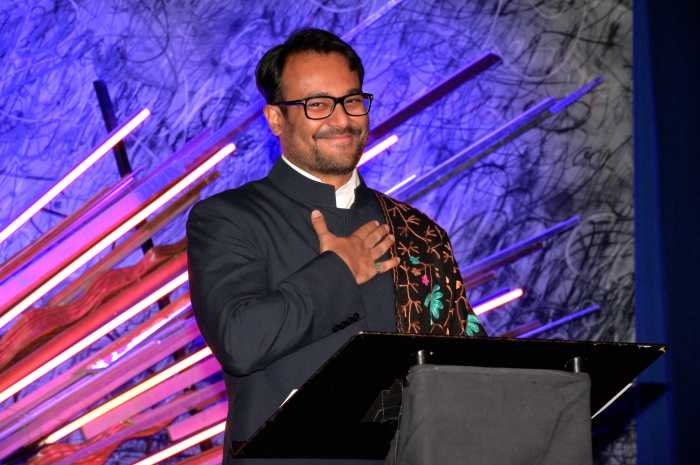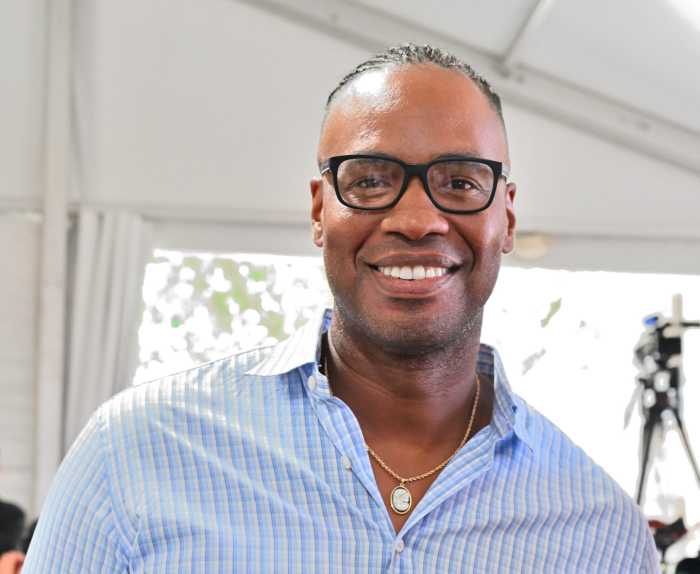NY Times story on anti-gay amendment reinforces concerns, raises outcry
Gay City News PHOTO
A front page, upper right hand corner story in The New York Times this past Sunday entitled “Strong Support Is Found For Ban on Gay Marriage” has reawakened concerns within the community that a backlash has emerged in response to recent legal and social gains, but also reignited complaints about coverage of queer issues in the nation’s newspaper of record.
And coming just four days before Christmas, the story’s timing may have made it difficult for community advocates to respond as strongly as they might have at other times of the year.
The story was based on a poll conducted on behalf of The Times and CBS News among 1,057 adults December 10 through 13. By a margin of 55 to 40 percent, respondents said that they favored “a constitutional amendment allowing marriage only between a man and a woman.” The story’s second paragraph noted that support for such an amendment “extends across a wide swath of the public and includes a majority of people traditionally viewed as supportive of gay rights, including Democrats, women, and people who live on the East Coast.”
The story also prominently featured data that showed that Americans oppose “a law allowing homosexuals to marry” by a margin of 61 to 34 percent and, by a margin of 49 to 41 percent, believe that “homosexual relations between adults should be not legal.”
The story noted that these findings come just a month after the highest court in Massachusetts ruled in favor of same-sex marriage and less than six months after the U.S. Supreme Court struck down the nation’s remaining sodomy laws in its Lawrence v. Texas ruling. The Times also reported that just last week, though after these poll results were collected, Pres. George W. Bush announced, for the first time, that he supports the anti-gay constitutional amendment, which has been introduced in both houses of Congress and has more than 100 sponsors in the House.
“I will support a constitutional amendment which would honor marriage between a man and a woman, codify that,” Bush told ABC’s Diane Sawyer. Later in the exchange, however, the president said that marriage should remain a state issue, “except and unless judicial rulings undermine the sanctity of marriage, in which case, we may need a constitutional amendment.” That statement suggested that Bush might not press for the amendment unless the federal Defense of Marriage Act (DOMA) were successfully challenged in court.
Response within the gay and lesbian community focused on two very different issues—one, whether The Times reporting represented good journalism, and two, how the same-sex marriage advocates should respond to the undeniable truth that powerful forces are arrayed against an idea on which the public is far from sold.
The Gay and Lesbian Alliance Against Defamation (GLAAD), which was the most visible in responding to the story, stuck pretty much to the issue of the reporting’s integrity. In a December 22 alert, the agency called the story “unbalanced and sensationalistic,” and said it failed to take account of the “understandably complex” and evolving response of the American people to the recent marriage and sodomy court rulings and of “the political nuance” in Bush’s statement last week.
The story, GLAAD concluded, was “beneath the journalistic standards of any reputable news media outlet.”
The GLAAD alert specifically quarreled with the characterization that 55 percent approval for the constitutional amendment was “strong” or signaled a depth of support required to steer it through the cumbersome ratification process. Constitutional amendments must be approved by two thirds of each house of Congress and then by 38 of the 50 state legislatures.
GLAAD also faulted The Times for the lack of pro-gay sentiment reflected in the story. In addition to Bush’s comments, the story included quotes from two anti-gay groups, the Traditional Values Coalition and Concerned Women for America, and from the amendment’s far right original sponsor, Rep. Marilyn Musgrave (R-Colo.). Winnie Stachelberg, the political director of the Human Rights Campaign (HRC), was the only pro-gay advocate cited. Sanford Levinson, a constitutional expert at the University of Texas Law School, was also quoted, warning that if the amendment were to “go anywhere, it would tear the Republican Party apart.”
Of four poll respondents quoted in the Times story, three were notably hostile to same-sex marriage; the fourth was identified as “one of the few people interviewed who was not opposed to legally recognized same-sex marriages,” despite the fact that one third said they favored them, and 40 percent opposed an amendment.
GLAAD also focused on the impact of such a story, especially appearing on the front page of the higher circulation Sunday edition. The alert noted that in the immediate aftermath of the story, CNN invited Lou Sheldon, head of the Traditional Values Coalition, to appear, giving him a platform to rail about “social disorder,” marriage being a matter of “where the body parts fit,” and what GLAAD said were other staples of “the anti-gay industry.”
Matt Foreman, executive director of the National Gay and Lesbian Task Force (NGLTF), voiced similar concerns about the impact the article could have on the emerging debate about same-sex marriage, but also warned that the amendment drive had plenty of momentum already.
“The story was appalling,” he said. “I am very concerned that it holds the real possibility of propelling, of pushing the amendment effort forward. But I may be in the minority, but I have always thought that the threat of an amendment is real. If Bush sends out the signal—and I don’t think he would do it publicly—that, “Let’s get moving on this,’ it could be a very real danger, especially in light of irresponsible reporting.”
Like GLAAD, Foreman felt the reporting in The Times lacked appreciation for “the political and polling nuance” of the same-sex marriage and the amendment issues involved. He also said that the statistics were not “significantly different that anything we’ve been seeing for a while.”
In polls released in July, USA Today and Gallup found Americans opposed to “legal civil unions” by a margin of 49 to 40 percent, while the Pew Research Center for the People and the Press found same-sex marriage losing 53 to 38. The numbers from The New York Times and CBS, with only 34 percent supporting “homosexual marriage,” then, reflect a further decline from what this summer was already being discussed as a backlash. The USA Today poll noted that support for legalizing same-sex conduct (overturning sodomy laws) had fallen from 60 percent in May to 48 percent in July. That number in the most recent poll was 41 percent.
Foreman argued, however, that these broad categories conceal subtleties in public opinion that he said have recently been examined in detail in focus groups carried out by both HRC and the gay and lesbian rights project at the American Civil Liberties Union (ACLU). Those focus groups demonstrate, Foreman said, that about a third of the country is strongly in support of the gay community on marriage, one third strongly opposed, with the middle third “clearly persuadable.”
Perhaps reflecting holiday vacation schedules, neither HRC’s Stachelberg nor Matt Coles, who heads up the gay rights effort at the ACLU, were available for comment. Evan Wolfson, the leader of Freedom To Marry and probably the best-known marriage advocate, is out of town until after the first of the year.
Foreman said that one key variable in the amendment discussion is its precise wording. The amendment’s current formulation restricts not only marriage status but also “the legal incidents thereof,” language which suggests to many that the constitutional change could undo a broad array of domestic partnership benefits around the country. Such a sweeping reversal is widely seen as dangerously radical, even among some conservatives. Foreman predicted that with this language, gay advocates can count on at least 34 Democrats and one Republican in the Senate to block approval of the amendment.
But, he said, if the language were tightened up, or if gay marriage became more clearly a defining issue in the presidential race, “then I am less confident.”
Foreman also said the community must be prepared to defend against an amendment in at least 13 states to block ratification should the measure clear Congress. He noted that there are currently eleven anti-marriage ballot initiatives unrelated to the federal amendment drive that could move forward in the years from 2004 through 2006—in states including Massachusetts California, Ohio, Wisconsin, Michigan, Minnesota, and Missouri.
“Our community has never won a single statewide marriage vote,” he warned. “How we will handle all of these simultaneously is an incredible hurdle.”
He said the community’s organizations will have to pool resources, raise an emergency fund numbering in the millions of dollars, and win three or four of the contests to stem the anti-marriage drive. Tough decisions about where to apply resources will have to made soon, Foreman said.
Among the good news coming out of The Times poll were some age and regional disparities. Americans under 30 support same-sex marriage by a margin of 56 to 40 percent, while those over 65 oppose it 79 to 14. Clearly, time is on the side of the gay community. Also, though each region in the country had a majority opposed to same-sex marriage, the numbers in the South were very skewed, 68 to 29 percent.
Steven Goldstein, who is working with Lambda Legal Defense and Education Fund on public education efforts related to the group’s lawsuit seeking same-sex marriage rights in New Jersey, took note of the regional differences. A Zogby International poll conducted on behalf of Lambda in July found residents of the Garden State in support of gay marriage by a margin of 55 to 41 percent, with majorities across most demographic groups.
“The powers that be in New Jersey, ranging from power brokers to activists to ordinary residents, feel comfortable with same-sex marriage,” he argued. “The Times numbers do not complicate things for us in New Jersey at all.”
In the wake of the Massachusetts marriage ruling, polls published by both Boston daily newspapers, the Globe and the Herald, found majority support for equal same-sex rights there as well. Goldstein said that similar strength has been recorded in polls in New Hampshire, Vermont, and California.





































